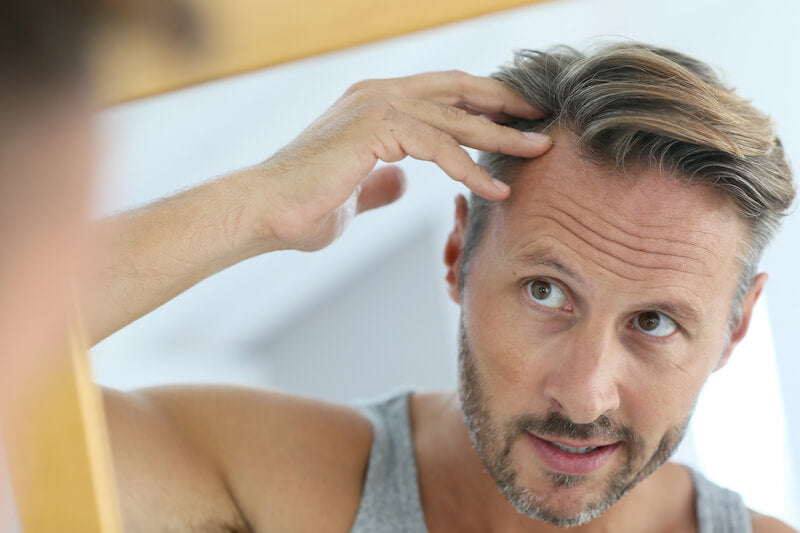| 04. July 2023
What are receding hairlines?

- The medical term for receding hairline is calvities frontalis and means “baldness of the forehead and temples”.
- Receding hairlines are an early sign of hereditary hair loss or androgenetic alopecia in men – sometimes also in women.
- In about 80% of men, receding hairlines appear during or immediately after puberty and expand over the course of their lives.
Many women believe that receding hairlines are a masculine characteristic. Many men like this statement: sparse hair isn't a flaw. However, well-informed men know that, when examined closely, an upward-moving forehead is a warning sign of hereditary hair loss and gradual hair loss. Time to act!
Causes of receding hairlines
The cause of receding hairlines is misprogrammed hair follicles that are highly sensitive to androgens such as dihydrotestosterone (DHT). DHT causes premature termination of the growth phase, meaning the hair cycle progresses in increasingly shorter periods, so that the hairs no longer grow beyond the size of downy hairs, effectively miniaturizing. Eventually, more and more hair follicles stop producing hair.
Baldness in three stages
A tonsure usually develops at the back of the head parallel to the development of the receding hairline. As the receding hairline merges with the tonsure over the years, a bald head gradually develops. However, the ring of hair from ear to ear remains.

Type 2
Frontal hair loss. Slight receding hairline.
Type 4
The forehead "moves" upward. A tonsure appears.
Type 7
A ring of hair remains from the originally full hair.
Tips against hair loss and receding hairlines
Most men who correctly identify the phenomenon of receding hairlines as hereditary hair loss wonder what remedies exist for receding hairlines. They also ask themselves: How can I combat my hair loss ? How can I improve hair growth? Here are some tips:
Concealing
To a certain extent, certain hairstyles help conceal a receding hairline. Razed-short hair can smooth the harsh transition from sparse to thick hair. Young men, in particular, benefit from letting their hair grow longer and tying it back at the back of the head. The higher hairline above the forehead then appears less noticeable, complementing the fullness of the overall hair.
Shave bald
The no-hair style, or self-inflicted baldness, is an irreconcilable contradiction for many men, as they combat hereditary hair loss by going hairless. But there's absolutely nothing wrong with this approach. Many men simply feel more comfortable with a bald head. The advantage: Instead of passively watching the increasing hair loss and expanding receding hairline, you take control of the situation.
Shampoo against hair loss
Shampoos with revitalizing plant extracts or stimulating caffeine are intended to stimulate the scalp to prolong the hair growth phase and thus reduce hair loss.
Hair transplant
As a remedy for receding hairlines and tonsure, more and more men are discovering hair transplantation (HT). Healthy hair follicles from the back of the head are transplanted to hairless areas of the skin. FUE method Growing popularity. Candidates for a hair transplant include men – but also an increasing number of women. However, their hair loss should have more or less reached a final stage. As long as hair loss progresses, a hair transplant is not the first therapeutic choice.
Nutrition
A balanced diet supplies hair follicles with important building blocks and functional substances for hair cellular metabolism: from keratin-forming proteins to vitamins. Young men in particular, who prefer fast food and thus provoke deficiencies, should reconsider their eating habits.
Thiocyanate
An active ingredient* without side effects or interactions is the natural, body-own molecule Thiocyanate . The patented thiocyanate formula in Thiocyn Hair Serum relieves the hair roots of free oxygen radicals, counteracts disruptive factors like DHT, protects the hair from growth-impairing influences, and thus supports the hair follicles in their regeneration. When cell division stabilizes at the hair root as a result of daily thiocyanate administration and the hair cycle normalizes, the hair grows back.
Frequently asked questions to our service team
Where does the term receding hairline come from?
One of the most prominent victims is probably the poet prince and privy councillor at the court of Saxe-Weimar, Johann Wolfgang Goethe (1749 – 1832). In Austria, this hair loss pattern is called "Hofratsecken" (court hair corners), and in Switzerland, "Ratsherrenecken" (cousin corners).
Are receding hairlines normal?
Since 90% of Central European men develop receding hairlines, doctors refer to this as a normal variant. Hair loss above the temples is a slight deviation from a standard declared as ideal.
I'm developing a receding hairline and a tonsure. My brother isn't.
Receding hairlines are the typical pattern of hereditary hair loss. There's a high probability that receding hairlines are passed on from one generation to the next. The genetic predisposition for hair loss can be passed on to one child but not to another. The genetic predisposition for hereditary hair loss is present in both the father's and the mother's genes.
My hair is falling out in clumps right now. Why?
Androgenetic alopecia can manifest in men with a major hair loss around 20 years become noticeable. DHT causes premature, synchronous hair loss. The affected hairs detach from the scalp due to mechanical stimuli, such as when washing the hair. As dramatic as this hair loss may seem, it is essentially just the beginning of androgenetic alopecia.
Why is my hair miniaturizing?
The regrowing hair, or more precisely the hair follicles that begin a new hair cycle, continue to react sensitively to androgens. The hair cycle is overdriven. Before the downy hairs can develop into strong terminal hairs, they fall out again. This miniaturization of the hair, and not the frightening hair loss, is the real problem.
I thought my hair loss was over. Why is it starting again now, in my early 40s?
The second wave of hair loss around age 40 will likely expand the bald patches, thus initiating the merging of hairless areas between the receding hairline and the tonsure. The best course of action for affected men would be to continue to strengthen the hair roots prophylactically.
Can women get receding hairlines?
The relative increase in androgen levels due to estrogen deficiency at the onset of menopause can also lead to hereditary hair loss in women. Thinning hair is usually noticeable in the crown area. However, women can also be affected by receding hairlines.
Can hair die?
Hair cannot die because it consists of lifeless horny cells. However, hair follicles can die after they have gone through 10 to 20 life cycles and can no longer produce hair. In principle, this potential is sufficient to live to the age of 70 or 80 with a full head of hair. The problem is that many hair follicles can no longer produce hair substance by the late 20s or early 30s due to excessive hair cycles. Their lifespan, so to speak, has expired more quickly.
What nutrients do hair roots need?
To produce hair, hair roots need sufficient building blocks such as proteins for the formation of hair keratin, energy in the form of glucose, and functional substances such as vitamins, trace elements, and thiocyanate. The bioactive molecule thiocyanate counteracts growth-inhibiting influences on hair cell division and growth through the targeted detoxification of oxygen radicals, which are produced as byproducts of cellular metabolism.
Receding hairline at 20, why?
Men don't have to be 40 or 50 to experience a receding hairline. Hair loss at the temples begins after puberty if there's a genetic predisposition. Receding hairlines are the first sign of hereditary hair loss.
Hair transplant for receding hairline?
Experts recommend avoiding hasty decisions when it comes to hair loss. A good time for men to consider a hair transplant is around age 30, when hair loss and hair miniaturization have initially become established. Until then—from 20 to 30—there is plenty of time to strengthen the hair roots and prevent factors that could disrupt growth.
READ BY 23,000 PEOPLE
Join 23,000 others and find out how to improve your hair health with great offers and discounts as well as helpful advice











